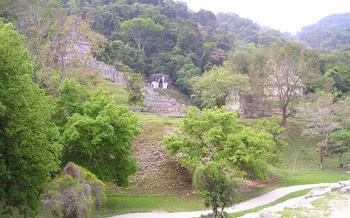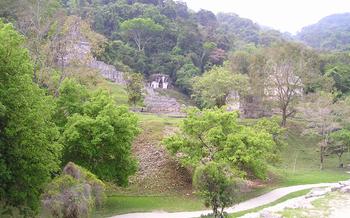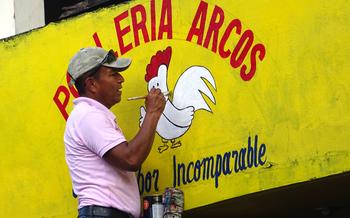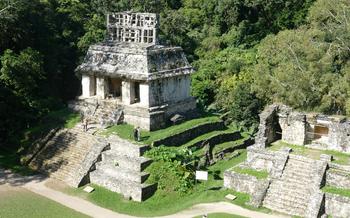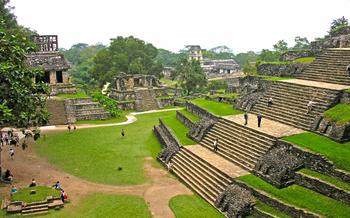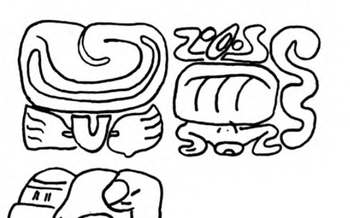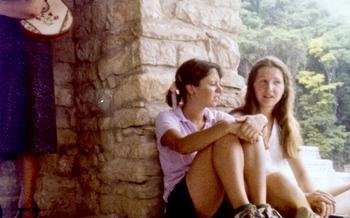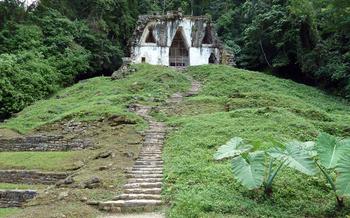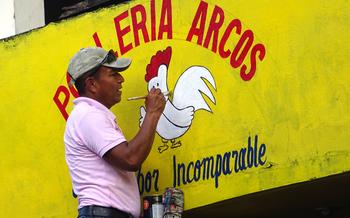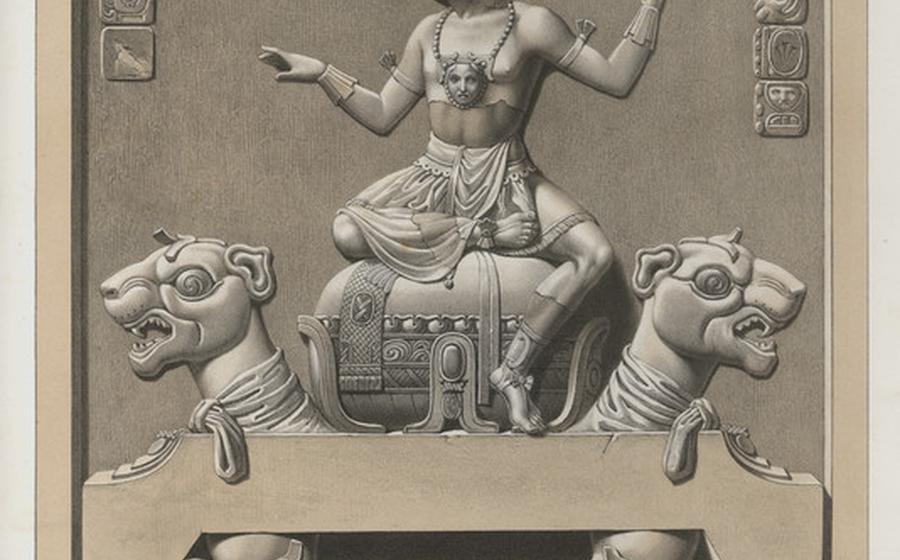
Temple of the Lion
- Palenque's Temple of the Lion: A Journey Through Time
- Location and Getting There
- Visiting Hours and Fees
- Exploring the Temple
- The Lion Throne
- Surrounding Temples and Structures
- Maya Civilization and Culture
- Local Guides and Tours
- Palenque National Park: A Natural and Cultural Sanctuary
- Photography and Videography
- Dress Code and Etiquette
- Souvenirs and Local Markets
- Accessibility and Facilities
- Nearby Attractions and Activities
- Insider Tip: Sunrise and Sunset Views
Palenque's Temple of the Lion: A Journey Through Time
Historical Significance
Palenque, a once-thriving city of the ancient Maya civilization, stands as a testament to the ingenuity and artistry of this remarkable culture. The Temple of the Lion, a majestic structure within the city, holds immense historical significance. Built in the 7th century AD, it served as a royal tomb and a sacred place of worship for the Maya rulers. The temple's intricate carvings, bas-reliefs, and hieroglyphic inscriptions offer valuable insights into Maya history, religion, and cosmology. Recognized for its exceptional cultural and architectural value, the Temple of the Lion, along with the entire city of Palenque, was designated a UNESCO World Heritage Site in 198
Location and Getting There
The Temple of the Lion is situated within the ancient city of Palenque, located in the southern Mexican state of Chiapas. The nearest airport is Palenque International Airport (PQM), approximately 10 kilometers from the city center. Visitors can easily reach Palenque by air from major cities in Mexico, including Mexico City and Cancun. Once in Palenque, travelers can take a taxi or colectivo (shared van) to the archaeological site, which is just a short distance from the city center. Alternatively, visitors can opt to walk to the site, enjoying the surrounding natural scenery and immersing themselves in the local atmosphere. Guided tours are also available, providing a more comprehensive experience with insights from knowledgeable guides.
Visiting Hours and Fees
The Temple of the Lion, along with the entire Palenque site, is open to visitors daily from 8 am to 5 pm. It is advisable to arrive early in the morning to avoid the midday heat and crowds, especially during the peak tourist season. Plan to spend at least two to three hours exploring the temple and the surrounding ruins.
The entrance fee for the Palenque site, which includes access to the Temple of the Lion, is currently 80 Mexican pesos (approximately 4 US dollars) for foreign visitors. There are discounts for students and children, and free admission for Mexican citizens and residents on Sundays.
Advance ticket purchase is not necessary, as tickets can be purchased directly at the site's entrance. However, if you are visiting during a particularly busy period, it might be advisable to arrive early to avoid long lines. Consider joining a guided tour for a more comprehensive and informative experience.
Exploring the Temple
The Temple of the Lion stands as a testament to the architectural prowess and artistic brilliance of the Maya civilization. Its exterior showcases intricate carvings depicting scenes from Maya mythology and history, while the interior chambers reveal a treasure trove of well-preserved paintings and bas-reliefs. The most striking feature of the temple's interior is undoubtedly the series of bas-reliefs adorning the walls. These intricate carvings depict various Maya rulers and deities engaged in ceremonial rituals and everyday life. The level of detail and artistry displayed in these bas-reliefs is simply astonishing, providing a glimpse into the rich symbolism and iconography of the Maya culture.
Each bas-relief tells a story, often referencing historical events, religious beliefs, and the lineage of Maya rulers. One particularly notable bas-relief portrays a Maya ruler seated on a throne, surrounded by his court and engaged in a ritual bloodletting ceremony. The vivid depiction of the ruler's elaborate headdress and ceremonial attire offers a fascinating insight into the power and prestige of Maya kingship. These bas-reliefs are not mere decorations; they serve as historical documents, providing valuable information about the lives, beliefs, and rituals of the ancient Maya people.
The Lion Throne
Amidst the sacred chambers of the Temple of the Lion, a majestic sculpture captures the attention of visitors with its enigmatic presence—the Lion Throne. Carved from a single block of limestone, this colossal throne exudes an aura of power and authority. Its feline form, adorned with intricate carvings and glyphs, symbolizes the Maya rulers' connection to the jaguar, a revered animal in Maya mythology.
The Lion Throne served as a ceremonial seat for Maya rulers during important rituals and ceremonies. Its placement within the temple's inner sanctum suggests its significance as a symbol of divine authority. The jaguar's sharp claws, bared fangs, and piercing gaze instill a sense of awe and respect, reflecting the ruler's status as a fierce protector and guardian of the realm.
The throne's intricate carvings depict various scenes and symbols related to Maya mythology and history. These carvings provide valuable insights into the beliefs and practices of the ancient Maya, offering glimpses into their complex cosmology and the divine lineage of their rulers.
The Lion Throne stands as a testament to the artistry and craftsmanship of the Maya civilization. Its exceptional preservation allows visitors to marvel at the skill and attention to detail that went into its creation. As you gaze upon this iconic sculpture, you can't help but feel a connection to the past, transported back in time to witness the grandeur of the Maya civilization.
Surrounding Temples and Structures
Beyond the Temple of the Lion, Palenque boasts several other notable temples and structures that offer a glimpse into the architectural prowess and cultural richness of the Maya civilization. The Temple of the Inscriptions, situated atop a natural hill, is renowned for its intricate carvings, hieroglyphic inscriptions, and an impressive tomb discovered beneath its pyramid. The Temple of the Cross, with its well-preserved stucco reliefs depicting Maya rulers and deities, provides further insight into the religious and political aspects of Maya society.
The Temple of the Sun, located to the east of the Temple of the Lion, showcases a unique circular design and contains important astronomical alignments. The Temple of the Foliated Cross, situated in the southern part of the site, displays elaborate stucco ornamentation depicting mythical creatures and scenes from Maya mythology. These surrounding temples and structures, along with the Temple of the Lion, form an interconnected complex that reveals the grandeur and complexity of the ancient Maya city of Palenque.
The architectural similarities among these structures include their stepped pyramid shape, the use of corbeled arches, and decorative elements such as stucco reliefs and sculptures. However, each temple also exhibits unique features and variations, reflecting the diverse artistic styles and functions of these sacred spaces. The Temple of the Lion, for example, stands out with its impressive size, intricate carvings, and the iconic Lion Throne, while the Temple of the Cross features a cross-shaped roof comb and well-preserved stucco reliefs.
The historical relationships and timelines of construction of these temples are closely intertwined, with each structure contributing to the overall development and expansion of the ancient city. The Temple of the Lion, built during the reign of King Pakal the Great, represents a pivotal point in Palenque's history, marking the transition to a new era of prosperity and power. The other temples were constructed during different periods, reflecting the continuous growth and transformation of the city over several centuries.
Exploring the surrounding temples and structures provides a comprehensive understanding of the interconnectedness and overall layout of the ancient city of Palenque. Visitors can trace the evolution of Maya architecture, appreciate the diverse artistic expressions, and gain insights into the religious beliefs and cultural practices of this remarkable civilization.
Maya Civilization and Culture
The Temple of the Lion stands as a testament to the ingenuity and creativity of the ancient Maya civilization. This advanced society flourished in the region for over a thousand years, leaving behind a rich legacy of cultural achievements. Religion played a central role in Maya life, with elaborate rituals and ceremonies performed in temples like the Temple of the Lion. The Maya were also skilled astronomers, developing complex calendars and tracking celestial events with remarkable accuracy. Their mathematical prowess is evident in their sophisticated system of hieroglyphics, used to record their history, mythology, and astronomical observations.
The artistic expressions of the Maya people are particularly striking, as seen in the intricate carvings and bas-reliefs that adorn the Temple of the Lion. These artworks showcase a deep understanding of human anatomy, nature, and the supernatural world. The Maya also excelled in painting, creating vibrant murals that depicted scenes from their daily lives, religious beliefs, and historical events. Their legacy continues to inspire and captivate modern-day visitors, providing a glimpse into the vibrant and sophisticated civilization that once thrived in the heart of the Maya world.
Local Guides and Tours
Engaging a local guide for your exploration of the Temple of the Lion and Palenque is highly recommended. These knowledgeable individuals provide an unparalleled insight into the history, culture, and significance of this ancient Maya city. Immerse yourself in the captivating stories and anecdotes brought to life by their expertise, enhancing your understanding and appreciation of the site.
Multiple tour options are available, catering to different interests and preferences. Join group tours for a sociable and budget-friendly experience, or opt for private guided visits for a personalized and in-depth exploration. Consider the cost and duration of each tour when making your selection.
To ensure a rewarding experience, choose a guide who is certified, experienced, and passionate about Maya history and culture. Their knowledge and enthusiasm will transform your visit into an unforgettable journey through time.
Palenque National Park: A Natural and Cultural Sanctuary
Beyond the awe-inspiring Temple of the Lion, the sprawling expanse of Palenque National Park invites you to immerse yourself in its natural wonders. Designated as a UNESCO World Heritage Site, this park encompasses a diverse ecosystem of lush rainforests, cascading waterfalls, and an abundance of wildlife. Explore the many hiking trails that wind through the park, offering opportunities to spot exotic birds, monkeys, and other native creatures. Allow yourself to be captivated by the harmonious blend of nature and culture as you discover ancient ruins tucked away within the dense vegetation, remnants of a civilization that once flourished in this sacred landscape.
The park's most prominent landmark, the Temple of Inscriptions, stands as a testament to the Maya's architectural prowess and their deep connection to the cosmos. Ascend the steep staircase to the temple's summit and be rewarded with panoramic views of the surrounding jungle canopy and the distant mountains. Immerse yourself in the tranquility of the park's natural pools and waterfalls, inviting you to cool off and rejuvenate amidst the serene surroundings.
Palenque National Park offers a unique blend of cultural heritage and natural beauty, providing visitors with an unforgettable experience. Whether you're an avid hiker, a wildlife enthusiast, or simply seeking a peaceful retreat, this park has something to offer everyone. Discover the wonders that lie within, and let the spirit of the ancient Maya guide you on your journey through time and nature.
Photography and Videography
Photographers and videographers are welcome to capture the beauty of the Temple of the Lion, but certain guidelines must be followed to ensure respect for the site and other visitors. The best lighting conditions for photography are early morning and late afternoon, when the sun's rays cast a warm glow on the temple's intricate carvings. Tripods are allowed, but they should not obstruct walkways or other visitors' views. Flash photography is not permitted, as it can damage the ancient paint and carvings. When filming or photographing, it is important to remember that the Temple of the Lion is a sacred site, and visitors should avoid disturbing or disrespecting other visitors or the site itself.
Dress Code and Etiquette
When visiting the Temple of the Lion, it is crucial to adhere to proper dress and etiquette to respect the cultural and religious significance of the site. Visitors should dress modestly and refrain from wearing revealing or overly casual clothing. Shorts, tank tops, and beachwear are generally not suitable attire for exploring the temple. It is recommended to wear comfortable, lightweight clothing that covers the shoulders and knees.
Noise levels should be kept to a minimum, and visitors are expected to maintain a respectful and peaceful atmosphere. Refrain from talking loudly or engaging in disruptive behaviors that may disturb other visitors or detract from the tranquility of the site. Touching or climbing on ancient structures is strictly prohibited, as these actions can damage or destroy valuable historical artifacts.
Souvenirs and Local Markets
Authentic Maya Crafts: - Discover a treasure trove of souvenirs and local handicrafts inspired by the Temple of the Lion and Maya culture. - Support local artisans by purchasing their unique creations, from intricate pottery to colorful textiles.
Local Markets and Shops: - Immerse yourself in the vibrant atmosphere of local markets, where vendors display an array of handmade goods. - Find everything from traditional Maya clothing to hand-carved wooden masks and jewelry.
Bargaining Tips: - Embrace the art of bargaining with local vendors to secure the best prices for your souvenirs. - Remember to approach negotiations with respect and a smile, and be prepared to walk away if the price is too high.
Unique Mementos: - Bring home a piece of Palenque with you by choosing souvenirs that are both beautiful and meaningful. - Consider purchasing a miniature replica of the Temple of the Lion or a handcrafted jaguar figurine to commemorate your visit.
Accessibility and Facilities
The Temple of the Lion and Palenque site are committed to providing a welcoming and accessible experience for visitors of all abilities. Wheelchair accessible ramps and designated parking spaces are available for those with limited mobility. Restrooms are conveniently located throughout the site, and drinking water fountains offer refreshment during the warm Mexican climate.
Although the temple's exterior is wheelchair accessible, the interior chambers and staircases present challenges for visitors with mobility impairments. However, an elevated walkway with interpretive signs provides an alternative way to experience the temple's interior and learn about its history and significance.
For a more comfortable and safe exploration, visitors are advised to wear comfortable shoes and clothing suitable for walking on uneven surfaces. The use of walking sticks or canes is permitted, and assistance from a companion or guide is recommended for those who require additional support.
By implementing these accessibility features and facilities, the Temple of the Lion and Palenque site strive to ensure that all visitors can enjoy and appreciate the wonders of this ancient Maya city.
Nearby Attractions and Activities
Beyond the Temple of the Lion, Palenque offers a wealth of additional attractions and activities to enrich your visit. Immerse yourself in the history and culture of the Maya civilization at the Palenque Museum, showcasing artifacts and exhibits that shed light on their remarkable achievements. Escape the urban hustle and bustle at the Agua Azul Waterfalls, a series of cascading waterfalls set amidst a lush jungle backdrop.
Venture beyond the city limits for an authentic glimpse into local life. Embark on a day trip to nearby towns and villages, where you can interact with the friendly locals, visit traditional markets, and savor the flavors of regional cuisine. Palenque's culinary scene is a delight, offering a range of restaurants serving both traditional Maya dishes and international fare.
Plan a comprehensive itinerary to make the most of your time in Palenque. Allocate at least two days to explore the Temple of the Lion, the Palenque Museum, and the Agua Azul Waterfalls. If time permits, consider extending your stay to delve deeper into the region's rich cultural heritage and natural wonders. Palenque offers a truly immersive experience that will leave you with lasting memories.
Insider Tip: Sunrise and Sunset Views
The Temple of the Lion offers a truly unforgettable experience when visited during sunrise or sunset. As the first rays of light illuminate the ancient structure, the intricate carvings and bas-reliefs come alive, casting dramatic shadows that enhance their beauty. Similarly, as the sun sets, the temple takes on a warm, golden glow, creating a mesmerizing spectacle.
To capture these breathtaking moments, plan your visit accordingly. For sunrise, aim to arrive at the temple around 6:00 AM, allowing ample time to find the perfect viewpoint and set up your camera. For sunset, plan to arrive around 5:00 PM, ensuring you have enough time to witness the gradual transformation of colors as the sun descends.
When choosing a viewpoint, consider the surrounding landscape and the angle of the sun. The best shots are often obtained from elevated positions or from within the temple itself, allowing you to capture the structure against the backdrop of the lush jungle or the setting sun.
Remember to respect the tranquility of the site and minimize noise and distractions during these special moments. By following these tips, you'll create lasting memories of your visit to the Temple of the Lion, capturing its beauty in all its glory.

